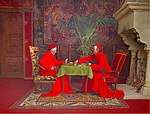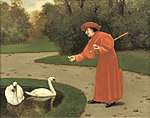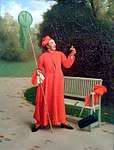Leo Herrmann
Leo Herrmann (born 2 July 1853 – 1927) was a French anti-clerical painter.
Herrmann was educated at the École des Beaux-Arts,[1] by Ernest Meissonier.[2] He entered the Parisian art scene in 1875 at the Paris Salon.[1] There, he became a successful artist, creating works that depict cardinals wearing red cassocks in comical scenarios.[3]
Works
| Wikimedia Commons has media related to Leo Herrmann. |
His first painting, shown in 1875, is A Bout d'Argument. Others include La Bonne Histoire (1876), Le Scandale du Jour (1877), Au Rendez-Vous (1887), Le Goûter (1889), Au Cabare (1896),[1], The Cordon Bleu, Suzette's Slipper,[4] and L'incroyable.[5]
 The Ace of Hearts
The Ace of Hearts Feeding Time
Feeding Time Butterfly Hunting
Butterfly Hunting The Cardinal's Nap
The Cardinal's Nap
References
- 1 2 3 Singer, Isidore; Haneman, Frederick T. (1906). "Herrmann, Leo". Jewish Encyclopedia.
- ↑ "Macmillan's Magazine". Vol. 50. New York. 1884. p. 95 – via Google Books.
- ↑ "Leo Herrmann". Haynes Fine Art. Haynes Fine Art of Broadway. Retrieved 4 August 2017.
- ↑ Catalogue of the Private Gallery of Valuable Paintings Belonging to Mr. Edward M. Knox. American Art Association. 1906. Nos. 10 & 48 – via Google Books.
- ↑ "More New Pictures". The Detroit Art Loan Record. H.A. and K.B. Ford (125): 164, 173. 1883 – via Google Books.
This article is issued from
Wikipedia.
The text is licensed under Creative Commons - Attribution - Sharealike.
Additional terms may apply for the media files.